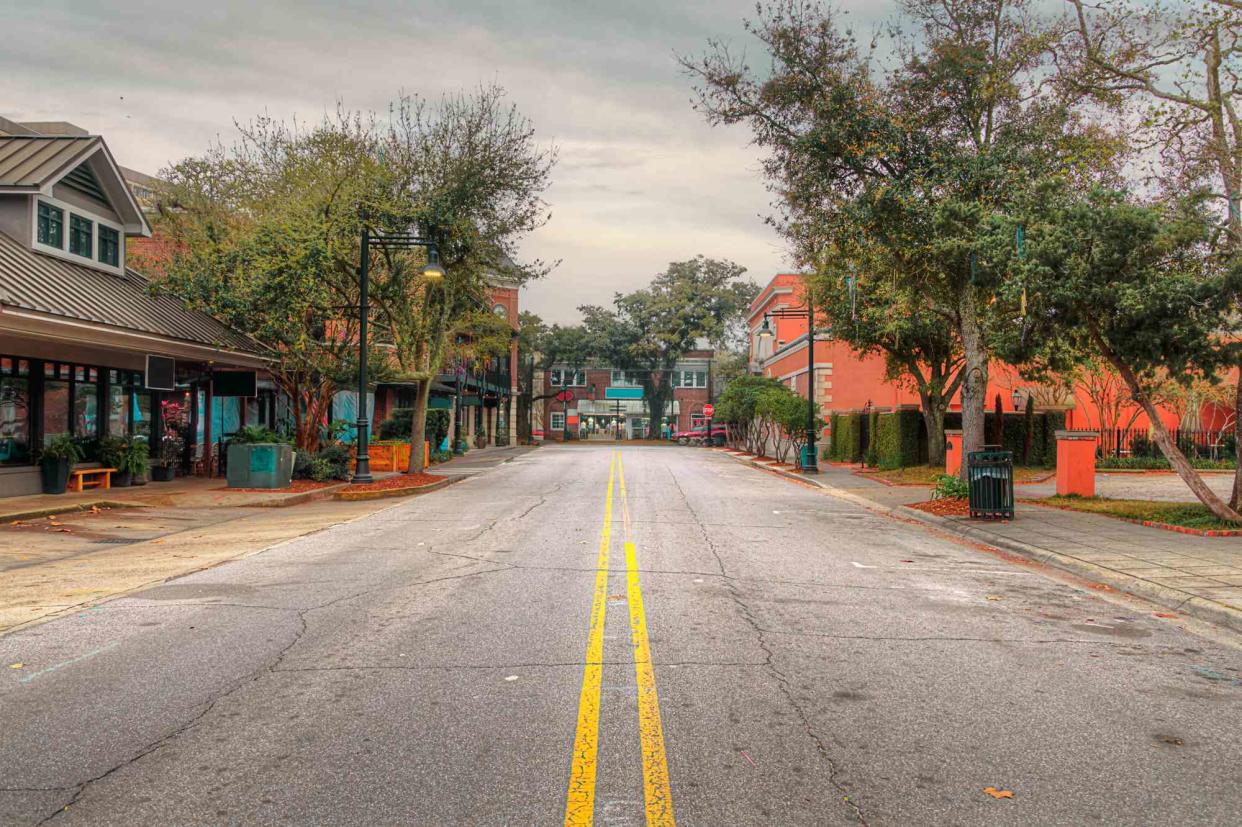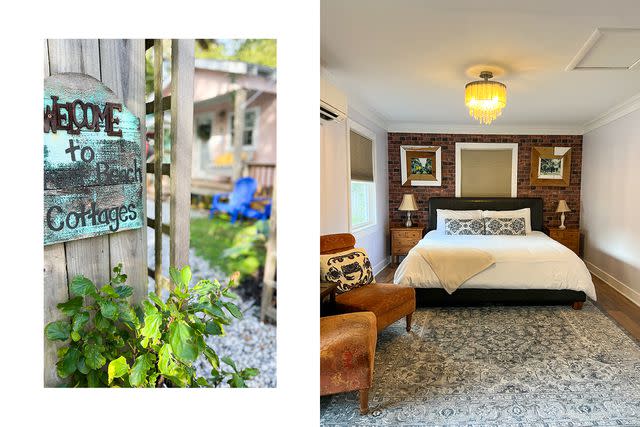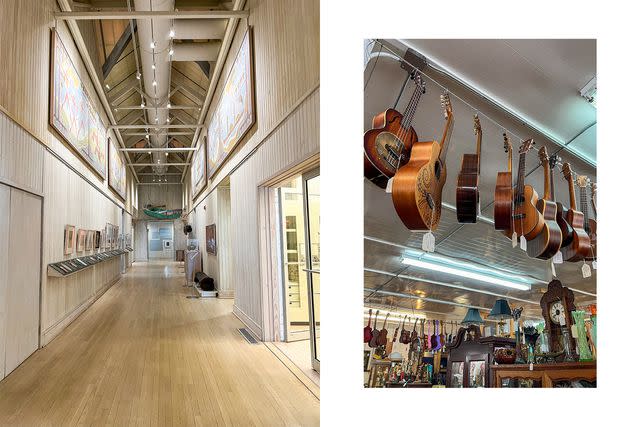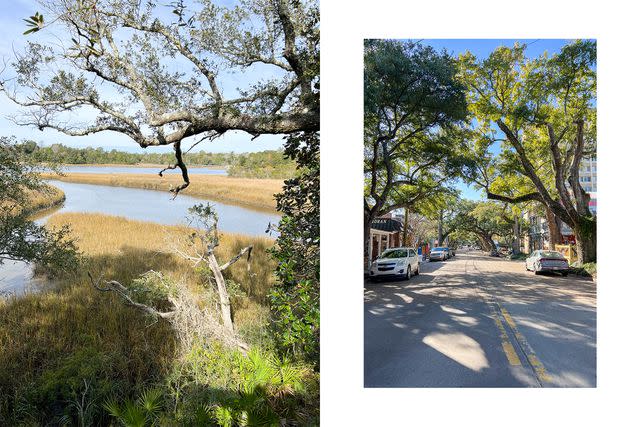This Under-the-radar Coastal Mississippi Town Is Finally Getting the Attention It Deserves — and It's the Perfect Day Trip From New Orleans

larrybraunphotography.com/Getty Images
Behind the swinging bookshelf of the speakeasy, tonight’s performer plays an acoustic set. Typically, the musical acts perform outside on the porch, but it’s as cold as Ocean Springs, Mississippi, ever gets, so he's moved the show to the back room of The Wilbur Bar. It’s a tiny, dimly lit space with fewer than 20 seats, and I’m the only person who doesn’t know everyone else in the room.
When I envision live music in Mississippi, I picture the blues clubs of the Delta or the country cover bands of the neighboring coastal town’s beach bars. This is a quieter, more refined experience. I order an apple cocktail from the seasonal menu while the singer plays an acoustic rendition of “Sympathy for the Devil.” This bar isn’t what I’ve come to expect of Mississippi, my home state. I’d describe the town the same way.
At first glance, Ocean Springs is the epitome of a traditional Mississippi town. The houses have rocking chairs on wraparound porches and resurrection ferns envelop the live oaks that canopy the historic downtown’s main street. Upon closer inspection, it’s clear this isn’t the Mississippi I grew up in. Amid the dozens of art galleries, antique shops, and restaurants, there’s also a vegan soap store and a plant-based skin care shop. There are several boutique hotels — including The Roost where The Wilbur Bar is located — full of modern decor. People drive golf carts instead of cars, and several international restaurants and a pet shop have a home here. More than once, I’m given an environmentally friendly straw.
Tonight’s audience, however, could only exist in Mississippi. “Whatever happened to Elvis?” one woman asks her group of friends. “Well, he died” a man replies. They gasp with laughter at themselves. The singer appeases us with an oddly beautiful version of Johnny Cash’s “Folsom Prison Blues.” I stay for the whole set until one of the female bartenders thanks the singer with a “my sweet angel baby” and hands him an envelope with his payment for the night.

Kayla Michelle Smith/Travel + Leisure
I’ve come to Ocean Springs for the weekend from my home in New Orleans. Most visitors overlook the Mississippi coast for trips to New Orleans, but a few of the state's coastal towns are finally getting the recognition they deserve. USA Today recently named Ocean Springs one of the best coastal small towns in the U.S., as well as Bay St. Louis, just 30 miles to the west.
Amtrak also recently announced they intend to reopen the passenger line between New Orleans and Mobile later this year, which hasn’t been in operation since Hurricane Katrina. The train will stop in Bay St. Louis and downtown Biloxi, a quick Uber ride from Ocean Springs. The route will make day trips possible for visitors who fly to New Orleans or Gulfport-Biloxi International Airport and don’t want to rent a car. The towns are ready to embrace new visitors.
My home in Ocean Springs for the weekend is Front Beach Cottages. Three of the property’s four cottages were originally fishing shacks from the 1940s, but they’ve been renovated and decorated with regional themes. I stay in the Lagniappe Cottage, a New Orleans-themed studio with a kitchenette, an indoor and outdoor shower, and a comfortable king-sized bed. The cottages sit just two blocks from the beach and have a collection of bikes, two kayaks, and a paddleboard available for guests to use for free. Two of the cottages are dog-friendly. Repeat guests come again and again, and the cottage’s owner knows everyone by name as if her guests are family, not strangers.
The New Orleans theme is common here, which makes sense as the region shares its French history. Ocean Springs was first founded in 1699 as Fort Maurepas, the first French settlement in the Mississippi River Valley. The name was changed to Ocean Springs in the mid-1800s because of mineral springs in the area that first brought tourism to the town.
I walk the two blocks from the cottages to watch the sunset on the beach. Though the flashy casinos and tourist shops of Biloxi are just 10 minutes away, the beach in Ocean Springs is untouched by commercialism. I pass dog walkers and a group of teenagers huddled around a fire pit celebrating a birthday. I watch from a public pier as the sinking sun creates an oil painting behind the silhouette of Biloxi across the bay.
The next day, I head to the main attraction in town — the Walter Anderson Museum of Art. Walter Anderson is practically a household name in the region, but I had no idea how little I knew about the artist until visiting the museum. I assumed the optional introductory video would be a 10-minute overview. Instead, the film lasted nearly an hour, and I was riveted the entire time.
Anderson was born in New Orleans in 1903 and moved to Ocean Springs in 1929. He was captivated by the nature of coastal Mississippi and spent the rest of his life trying to capture it. His biggest muse was Horn Island. He would row his small boat to the barrier island, about a dozen miles off the coast of Ocean Springs, and spend weeks alone painting and sleeping in his boat. Near the end of his life in 1965, Anderson tied himself to a tree on Horn Island to ride out Hurricane Betsy (which would be classified as a Category 4 storm today). He wanted to experience nature at its most extreme.
Unfortunately, another storm would later destroy much of his life’s work. In 2005, Hurricane Katrina destroyed the showroom, studio, and part of the property at Shearwater Pottery — the shop in town opened by Anderson’s brother, Peter, and where Walter lived and worked for the last two decades of his life. In the aftermath of the storm, his family (who still owns the property) and neighbors dug through the mud searching for bits of pottery and whatever paintings they could find. The local community helped in the search, and pieces of his art were recovered and brought back to Shearwater from as far as a quarter mile away. The Mississippi coast is a place that demonstrates resilience again and again, and Shearwater has since rebuilt.

Kayla Michelle Smith/Travel + Leisure
In the museum, I explore the Mississippi coast through the eyes and imagination of Walter Anderson. The final room I visit is the Community Center, which sits adjacent to the museum through a conjoined hallway. This is where Anderson was commissioned to paint a mural spanning all 3,000 feet of the space. In the Community Center, I meet John Albrycht who, at 90 years old, is still volunteering for the museum. After his wife passed away eight years ago, his doctor told him he needed to get out of the house and find a way to fill his time, so he went to the museum where he and his wife had been members. Other than a year-long break during the height of the pandemic, he’s been volunteering there ever since, sharing his love and knowledge of the artist and region. Like Anderson, Albrycht moved to the Mississippi coast in his twenties and never left.
When I ask him about his Hurricane Katrina experience, he tells me there was a knock on his door that Monday morning as the worst of the storm was raging. When he opened the door, he found six adults, three kids, and a cat on his doorstep. They’d waded through his flooded yard to reach his house, seeking shelter from the storm. He and his wife fed them a meal, and they rode out the rest of the storm together. The water came within inches of flooding his house. Like his neighborhood, the historic downtown is a few blocks away (and slightly uphill) from the beach, so it remained mostly intact after Katrina. But much of the region has spent the past 18 years restoring and reinventing itself in the aftermath of catastrophic destruction.

Kayla Michelle Smith/Travel + Leisure
Today, the historic downtown is thriving. Visitors flock to town for its numerous festivals and events — the calendar is full of them year-round. There are family-friendly Mardi Gras parades, arts and crafts fairs, food and music festivals, and events to celebrate every holiday. And of course, the food draws people in. The Lady May has the best crab cakes I’ve ever consumed. At 701 Craft, you can have lunch or craft cocktails overlooking the bayou. And at Mosaic, there’s live music on the large patio every night and you can choose from regional dishes or international small plates.
A few miles from downtown, I visit Davis Bayou, part of the Gulf Islands National Seashore. This protected nature preserve is full of trails, wildlife, and the marshlands that used to cover this region before the human-made beaches were built. Here, you can catch a glimpse of alligators, turtles, and more than 280 species of birds.
Before leaving town, I stop at Realizations, a shop owned by Walter Anderson’s family which sells gifts featuring his block prints, including T-shirts, posters, framed prints, and ornaments.
On my way back to New Orleans, I drive along the coastal highway until I reach Bay St. Louis. Unlike Ocean Springs, Bay St. Louis suffered a direct hit from Hurricane Katrina. The nearly 30-foot storm surge that crashed into town wiped most buildings from their slabs. Almost nothing was left standing. I was in high school when Katrina hit, and I remember driving to Bay St. Louis a few months after the storm and seeing the piles of rubble that had once been homes, pushed inland as if by a giant bulldozer. Bay St. Louis today is unrecognizable from that 18-year-old memory.
Today, downtown Bay St. Louis is known for its nightlife, beach bars, antique shops, and galleries. I arrive at Mockingbird Cafe and grab lunch just before they close. Born from the destruction of Hurricane Katrina, the cafe has been a local favorite since 2006. It strives to be environmentally friendly, using only biodegradable materials. Dolly Parton decor smiles at me while I eat my hash browns. After finishing my lunch, I rush a block down the street to Buttercup on Second Street, another cafe, to buy an excessive number of cookies.
I hop in and out of antique shops; browse local gifts at Social Chair, a local crafts and gift shop; and admire art in Gallery 220, a co-operative gallery where 25 local artists showcase their work. My last stop of the day is Cafe BoneJour — my favorite pet boutique where I buy my dog a treat before heading home.
Across the street lies the Bay St. Louis train depot. It’s under construction right now, preparing for Amtrak to announce the launch date of its coastal route. I feel pride when I think about the resilience of coastal Mississippi, the 18 years of reinvention these towns have steadily navigated, and how soon, more visitors will come to love these places, too.
For more Travel & Leisure news, make sure to sign up for our newsletter!
Read the original article on Travel & Leisure.

